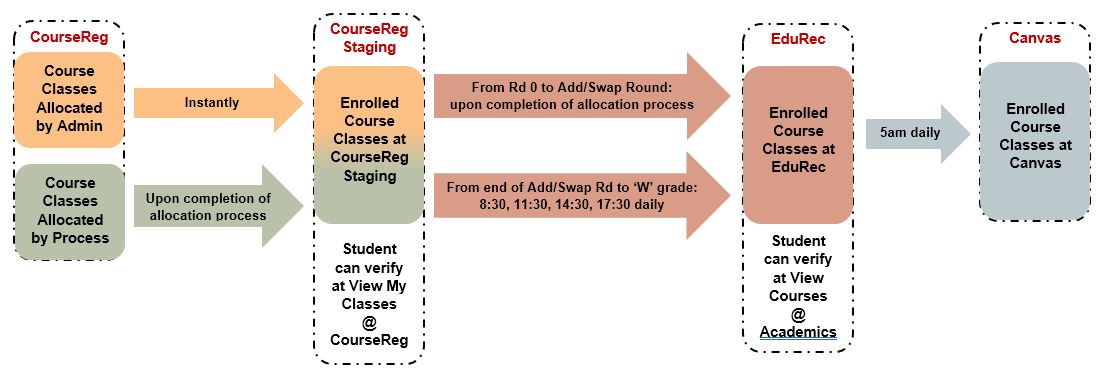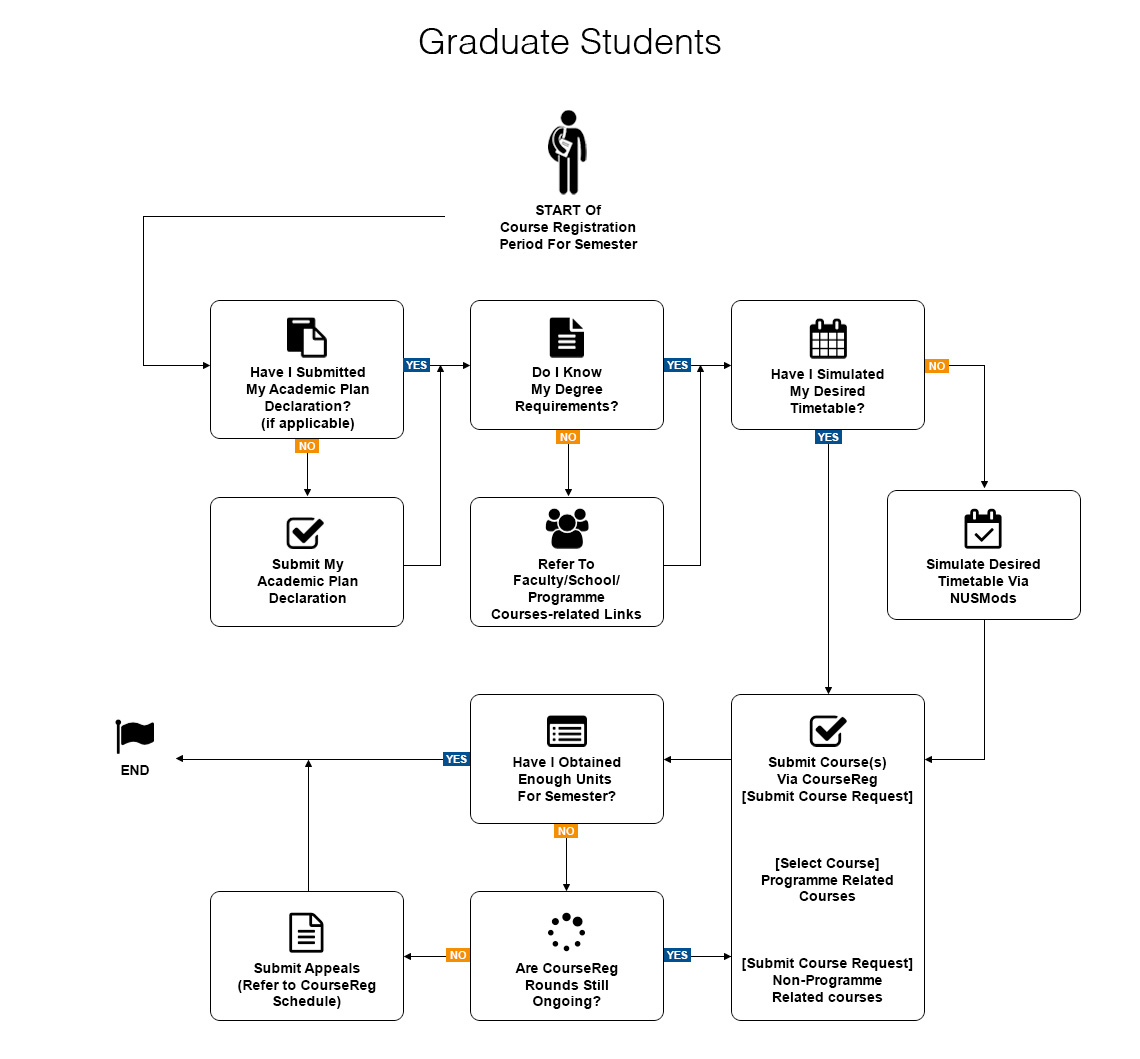Graduate Students
CourseReg@EduRec Functions & Rounds
The enrolment functions in CourseReg@EduRec, as well as information on how the different Registration Rounds will be conducted for each of the functions, are provided below.
Students are also strongly encouraged to refer to the CourseReg User Guide for Students, which provides screenshots on how to navigate within CourseReg.
All Undergraduate (UG) students will enrol for courses through the [Select Courses] function in CourseReg@EduRec.
Graduate (GD) students will enrol for courses through the [Select Courses] function for courses used towards their programme requirements (refer here).
Priority Scores computed for courses selected under this function will be based on the priority scoring rubrics.
-
Round 1
This is a protected round.
Students will be able to select courses (subject to meeting course pre-requisite, co-requisite and preclusion rules) in this round if the courses can be used towards:
(i) Programme (Core and Specialisation) requirements
(ii) Prescribed English requirements (i.e. courses offered by CELC)
Students will vie for a spot in the course within the available places allotted to their student category (e.g. separate numbers for UG and GD). -
Round 2
In this round, GD students may select all Round 1 courses and programme elective courses (from own and other departments).
Students will vie for a spot in the course within the available places allotted to their student category (e.g. separate numbers for UG and GD).
-
Round 3
This round is similar to Round 2 except that the balance quotas are merged for all categories of students (GD/UG/NG/CPE) to optimise class enrolment. That is, un-used quota from a particular category of students may be allocated to students from another category.
(Not applicable to UG students)
Graduate (GD) students will utilise this [Submit Course Requests] function to request for non-programme requirement courses (i.e. cross-faculty courses). The request will go through a two-step approval process: it is first routed to the home department for decision before approved requests are routed to the course host(s) for final assessment.
There is only one round of [Submit Course Requests] each semester.
With effect from Sem 1, AY2022/2023, Graduate Coursework (GDC) students taking non-programme requirement courses from self-funded (i.e. non-subsidised) programmes might be charged course fee for the course. Please contact the course host for more information.
Students will register for Tutorials/Labs after they have been allocated their courses. Students can refer to the [View My Classes] function to see the courses allocated to them.
Tutorial/lab registration is by balloting. The allocation of tutorial groups is an exercise that is separate from the allocation of courses by [Select Courses] or [Submit Course Requests]. Students should refer to the registration schedule for the dates of the different rounds for Tutorials/Labs registration.
For cross-listed courses that do not have tutorial groups of their own, please check the tutorial groups under the parent course code even though you may have registered under the cross-listed course code.
A tutorial group may be cancelled if enrolment for the group is low. If students cannot find a suitable tutorial group for a course, they may be required to drop the course and be asked to choose an alternative course with vacancies.
Students who read courses offered by the Faculty of Arts and Social Sciences have to register for tutorial groups for their courses. Otherwise, the Faculty will withdraw the course with a ‘W’ grade in Week 5 of the semester.
Stages of Tutorial Registration:
1. [Select Tutorials/Labs] Function
- There are 2 [Select Tutorials/Labs] rounds.
- For each round, students can select and rank 20 preferred Tutorial/Lab timeslots for all the courses that they are enrolled in. However, students must ensure that there are no timetable clashes between the ranked preferences and his/her existing class schedule.
- A student may list fewer than 20 ranked preferences, but this would mean that there are fewer preferences for the system to consider. A shorter list of preferences may also mean that a student may not be successful in getting a tutorial allocated at all.
- If, despite the provision of 20 ranked preferences, the student is still unsuccessful in being allocated the tutorial groups for his/her courses, the student may have to revise his/her preferences and re-submit the list of 20 ranked preferences for further balloting in the next round.
2. [Add/Swap Tutorials/Labs] Function
- The add/swap process begins after the last round of tutorial/lab balloting. Students without tutorial class can use this function to add tutorial class as long as there are still vacancies. The add request will be processed at frequent intervals and allocation is on first-come-first-served basis.
- If a student has already been successfully allocated a tutorial class but would like to change to another class that is currently full, he/she can post a swap request. The swap request will be processed at frequent intervals and will be effected when there is a corresponding match with another student. Otherwise, the request will be stored in the system until the time when a corresponding match is found. Students may check their tutorial/lab allocation in [View My Classes].
- If a add/swap request has been submitted but a student changes his/her mind, he/she must remember to delete the request to add/swap.
3. Submission of appeals for tutorials to Course Host Departments
- Appeals to departments should only be submitted after the student has tried but failed to secure a suitable tutorial timeslot using the above-listed methods. Students should note that they can appeal only for tutorial groups with vacancies. The departments will not accommodate students who regard appeal submission as the first course of action, instead of tutorial selection and add/swap.
- At the end of tutorial registration, a student who is still not enrolled in a tutorial due to timetable clashes may be allowed to drop the course.
Dropping of courses:
A student may drop a course he/she is enrolled in so long as the remaining Units meet the minimum workload requirement. When a course is dropped, all associated classes (e.g. lectures, seminar, tutorial, labs, etc.) will be dropped in tandem.
When dropping a course, students should be mindful of the “W” and “F” grade period (refer to Academic Calendar). In general, students will be able to drop courses via the [Drop Classes] function before the “F” grade period. A student should approach the course host faculty if he/she has difficulty dropping courses via CourseReg@EduRec.
Dropping of tutorial/lab classes:
Students may drop a tutorial/lab class they have been successfully allocated if they wish to change to another class. Dropping a tutorial/lab class will not de-enrol a student from his/her course.
Refer to CourseReg Schedule and Appeal Timeline for the available appeals of the current semester.
Priority Score and Tie-Breakers
Where demand for a selected course exceeds the available places, the Priority Scores of students seeking to read a particular course will be used to determine course allocation.
The Priority Score for a course selected by a student is computed based on the Priority Scoring Rubrics applicable to the different student categories.
| Programme Requirements Category (in descending order of points) - A |
|---|
| Programme core courses |
| Specialisation courses |
| Programme electives (from own department) |
| Programme electives (from other departments) |
| CELC courses |
| Students’ Seniority (in descending order of points) - B |
|---|
| Part-time/Full-time Senior |
| Part-time/Full-time Junior |
| Type of Programmes (in descending order of points) - C |
|---|
| Coursework |
| Research |
| Rank Preference of Courses (in descending order of points) - D |
|---|
| Rank 1 |
| Rank 2 |
| Rank 3 |
| Rank 4 |
| Rank 5 |
| Rank 6 |
| Rank 7 |
| Rank 8 |
When students have the same Priority Score for a course and the demand exceeds the places available, tie-breakers are used to determine the final course allocation. Below are the tie-breakers for graduate students
| Tie-breakers (in descending order of consideration) |
|---|
| Student's home faculty is course host faculty |
| Carded National Athletes (w.e.f. Sem 2, AY2022/23) |
| Course feedback points (not applicable to Yale-NUS courses) |
| Course Planning Exercise (CPEx) points (w.e.f. Sem 1, AY2021/22) |
| Random balloting |
Course Enrolment Data Workflow

-
CourseReg to CourseReg Staging
(Page to verify: View my classes @ CourseReg)
- Admin allocated: uploaded instantly
- Allocation process run: uploaded only upon completion of process run
-
CourseReg Staging to EduRec
(Page to verify: View courses under Academics)
- From Select Courses (Rd 1) to Add/Swap Tutorials: uploaded after allocation process runs are completed
- From end of Add/Swap Tutorials to end of ‘W’ grade: auto uploaded at 8.30, 11.30, 14.30, 17.30 daily
-
EduRec to Canvas: uploaded at 5am daily



